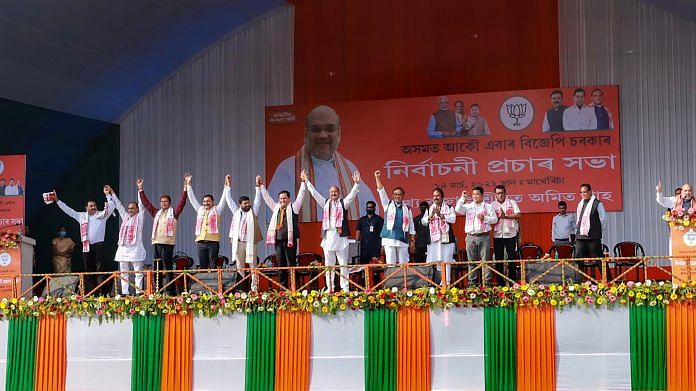New Delhi: This election season, ThePrint’s Editor-in-Chief Shekhar Gupta looked at the political landscape of the four states and one union territory headed to the polls — West Bengal, Tamil Nadu, Kerala, Assam and Puducherry. In episode 704 of ‘Cut the Clutter’, he talked about Assam and explained how the RSS won the state for the BJP and how it changed the state’s political fault line from anti-outsider to anti-Muslim infiltrator.
Gupta noted that the political power of states can be determined by the number of MPs it contributes. Assam has 14 MPs, so we can say that it is a state of the size of Jharkhand or Punjab. Assam is a very important border state with a fascinating mix of religions, linguistics and cultural diversity.
Gupta said the BJP was non-existent in Assam three decades ago, but it dominates the state now. It is routine for BJP to credit RSS for its election victories but in the 2014 Lok Sabha elections, it was more of Prime Minister Narendra Modi’s victory. However, in Assam, the RSS truly deserves the credit for having won it for BJP.
Gupta recalled that during his travels in Assam, as a young journalist, he kept coming across many dedicated pracharaks (full-time volunteers) of the RSS, who planted the seeds of its ideology and co-opted the Assam movement.
At that time, the Assam movement was equally vehement against both Hindu and Muslim immigrants from Bangladesh. The challenge for the RSS was to convert ethnic chauvinism, or regionalism, into an anti-Muslim mood. Until then, the mood was not anti-Muslim — it was a strong mood against anti-indigenous ethnicities, which essentially meant Bengali speaking people at that point, explained Gupta.
The RSS shifted this movement’s focus from all immigrants to only Muslim immigrants after working for over 30 years — and succeeded. To succeed in Assam, the BJP needed local leaders from the state. The RSS started cherry-picking leaders from the old Assam movement, that is from the All Assam Students Union (AASU) and Asom Gana Parishad (AGP), so much so that almost all Lok Sabha candidates in the 2014 elections were former AGP leaders.
BJP bought out all of the AGP and created a new leadership, which included Sarbananda Sonowal, the current chief minister. The BJP also brought on board the second most important person in the Congress after Tarun Gogoi — Himanta Biswa Sarma — who had joined AASU as a young kid and later joined the Congress. Sarma wanted to become CM but Congress had a succession system in place. So the BJP reached out to him and Sarma joined the BJP in 2015.
Also read: Amit Shah attacks Congress-AIUDF pact, says Assam can’t be safe in Badruddin Ajmal’s hands
The Muslim vote
The Assam movement was seen as anti-national. The RSS had to turn it into a nationalistic movement, which it achieved in the course of time, added Gupta. The RSS also broke the Congress party’s vote bank in Assam by getting on board the bulk of Ahoms, tea labourers and some of the Bengali speakers.
In Assam, the Barak valley border has a mostly Bengali-speaking population where the Muslims vote for whoever they think can defeat the BJP, but the bulk of the Bengali Hindu there vote for the BJP. This time, the Congress has gone a step ahead and taken the risk of signing up with the All India United Democratic Front (AIUDF) to prevent Muslim votes from being divided.
If we look at the rest of Assam, it can generally be divided into the south bank of Brahmaputra and the north bank of Brahmaputra. The south bank is more popular as the bigger cities like Guwahati, Jorhat, Dibrugarh, Golaghat — the constituencies in which tea garden labourers play a big role — are in this region. Kaliabor is the Gogoi family’s pocket borough — the late Tarun Gogoi used to win it and now his son Gaurav has won it, said Gupta.
On the north bank, there is Tezpur, Mangaldoi and Lakhimpur. In most of these seats, AIUDF does not matter — it is a straight fight between the Congress and the BJP, Gupta concluded.
Also read: Yogendra Yadav meets Akhil Gogoi, says goal is to defeat BJP




This becomes possible for massive development works done by BJP government. Corruptions are minimised. Law and order is maintained. In earlier, Assamese people were fed-up with AGP govt rule, then chooses Congress Govt. But congress Govt also failed to sustain development works and corruptions rosed to highest level. Fed-up with all, Assamese people sought BJP to take power and still they are great follower of the party.
I don’t believe this analysis is true. In fact is far from reality. I guess the writer was not on ground when the CAA movement took place. Looking at social media posts is not enough to write a comprehensive analysis of the sentiment of the state. The writer should also know that the so called vote banks and indigenous communities are poor and have limited presence on social media.